2018 School Spending Survey Report
Reviews of select titles by Peter Dickinson
Heartsease
by Peter Dickinson; illus.
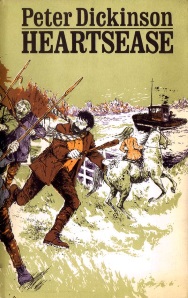 Heartsease
Heartseaseby Peter Dickinson; illus. by Nathan Goldstein
Little 223 pp.
1969 $4.95
A companion to The Weathermonger, set in a future time in England after the "Changes" which caused man to retrogress to dark medieval ways and to outlaw machines. Again, witchcraft is an element in the story, and again some of the few characters unaffected by the Changes seek to right wrongs. Margaret and her cousin Jonathan, helped by Lucy, a servant girl, and her brother Tim, succeed in saving a condemned witch — still breathing, although he had been buried under a pile of stones. They hide him, nurse him, and engineer a plan to get him to Ireland — a land free of the Changes — on a small tugboat they find and manage to restore to working order. The author writes economically, achieving great suspense; most of his story details the wild escape and chase. Although the story is independent of its predecessor, the fact that the Changes are referred to several times before being explained makes reading the earlier book a desirable prerequisite. Regrettably, in both books, the philosophy behind the Changes and details of the retrogression of man are insufficiently treated. VIRGINIA HAVILAND
From the April 1970 issue of The Horn Book Magazine.
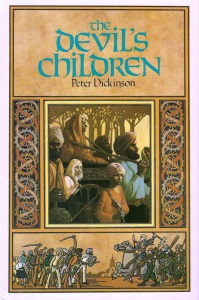 The Devil's Children
The Devil's Childrenby Peter Dickinson
Atlantic-Little 188 pp.
1970 $4.95
Written with more attention to detail than the other two books in the trilogy, this one is set in England at the beginning of the Changes, which turned the English against machinery of all types. Nicky Gore, a twelve-year-old schoolgirl who has been separated from her parents in the chaotic immigration to a still normal France, becomes the "canary" for a large Indian family which has escaped the English madness. As the Sikhs cannot understand all the aspects of the mania caused by the Changes, they need Nicky, who cannot control her sensitive reactions to mechanical things, to warn them of dangers they are unable to perceive, Because of their foreign customs and appearance, the Sikhs are met with fear and hatred when they try to make a home for themselves on a deserted farm outside of the village of Felpham, and Nicky is greeted with mistrust by the villagers because of her association with the "Devil's Children.'' It is not until the family proves itself in combat against the village's oppressors that they are accepted as warm, often fallible, but honorable and brave people. Nicky's story, however, remains unresolved, for the greatest danger she faces is from the protective shell she herself has wrapped around her emotions — to be shed only if she can ever find her own family in France. The author has created an exciting adventure story and told it well. Unfortunately, there may be some confusion for the reader who has not read the other two books first as to exactly what the Changes are. SHERYL B. ANDREWS
From the December 1970 issue of The Horn Book Magazine.
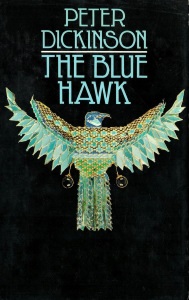 The Blue Hawk
The Blue Hawkby Peter Dickinson
Atlantic-Little 229 pp.
1976 $8.95
Suggesting high fantasy but without the literal intervention of the supernatural, recalling the historical patterns of bygone theocratic civilizations like those of ancient Egypt or Babylon, the story dramatizes the eternal conflict between tradition and change. Thirteen-year-old Tron, one of the boys chosen to be trained for the priesthood of the Hawk god Gdu, dared during a temple ceremony to interfere with the sacrifice of the Blue Hawk and thus inadvertently caused the death of the king. He had found a white stone, the Goat-Stone, baked into his breakfast loaf and was considered "sacred as a God for one whole day. Whatever he did during that day he could not be touched or punished." The priests banished him, however, to a deserted temple and instructed him to train the ferocious bird as a hunter. In the course of time, he met the new young king, who befriended him and explained the cause of the antagonism between the crown and the priesthood. Tron's development during the next six months became dual in significance. Although he remained true to the disciplines of his priestly training — singing and reciting traditional hymns and dancing in ceremonials appropriate to various solemn occasions — Tron developed a feeling that the gods were using him to further their purposes. On the other hand, as friend of the young king, he began to experience the length and breadth of the land and even what was beyond it. From the time Tron lay concealed with the Blue Hawk in the old king's coffin, which was being shipped down the great river on a barge, to the time he witnessed the invasion of ferocious blue-painted, horse-riding barbarians accompanied by huge hunting dogs, his experiences became an external adventure as well as a spiritual odyssey. PAUL HEINS
From the October 1976 issue of The Horn Book Magazine.
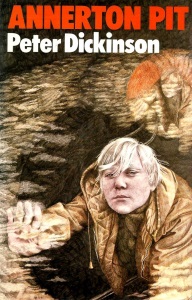 Annerton Pit
Annerton Pitby Peter Dickinson
Atlantic-Little 175 pp.
1977 0-316-18430-6 $6.95
A powerful, wholly original novel is constructed with enormous skill and written with rare perception and intuition. Thirteen-year-old Jake is totally blind but astonishingly percipient and capable; his brother Martin, however, five years his senior, is impulsive and a bit immature. While their parents are away on vacation, the boys become worried about their grandfather, whom they have not heard from recently. A retired mining engineer, the elderly man has been wandering around the north of England indulging in his favorite pursuit: hunting down ghost stories and ferreting out rational explanations of local legends about supernatural manifestations. Setting out on a motorcycle, the brothers journey northward in search of him. Various clues they pick up along the way lead them to an abandoned coal mine in which a group of miners enigmatically perished long ago and in which a band of dangerous revolutionary environmentalists now maintains its clandestine headquarters. Jake and Martin discover that Grandpa, having innocently blundered upon the hiding place, is being held captive by the terrorists; all three of them are now sealed away as hostages in the mine. Grandpa falls seriously ill with pneumonia; and in the story of their incarceration and of their attempts to escape from the chill, slimy, terrifying underground labyrinth, the horror of the deliberate, detailed writing approaches that of Poe. But there are also intimations of Dostoevsky, for the greatest impact of the novel is psychological Martin, who has secretly been an idealistic young supporter of the revolutionists, is placed in an agonizing situation; after the rescue by the police he must, ironically, become "the tool of the very system that scarred the green hills, poisoned river and sea, murdered plant and creatures and spun mankind faster and faster towards destruction." Moreover, he realizes miserably, "It's not much of a problem being right. It's doing right where the trouble begins — doing it and going on doing it while life comes up and hits you with situations where there aren't any rights to do." And left alone in the mine, sightless Jake undergoes a devastating mental experience and suffers the worst trauma of all; physically agile, intellectually keen, and uncannily sensitive, he is the real hero of the book. ETHEL L. HEINS
From the April 1978 issue of The Horn Book Magazine.
 Tulku
Tulkuby Peter Dickinson
Dutton/Unicorn 286 pp.
1979 0-525-41571-8 $8.95
China at the time of the Boxer Rebellion is the setting of a superb adventure novel seen through the eyes of thirteen-year-old Theodore Tewker, son of an American missionary. After his father's missionary settlement is destroyed, Theodore encounters Mrs. Jones, an intrepid middle-aged English botanist, and her young Chinese interpreter Lung. Mrs. Jones takes Theodore along with her, not only out of pity but because he is useful to her — speaking English, Mandarin, and various Chinese dialects. Although shocked by her coarse language and forthright attitudes, Theodore is impressed by her strength, independence, and vitality. The three of them journey to Tibet, pursued by bandits and traveling over difficult terrain. Along the way Theodore is horrified to realize that Mrs. Jones and Lung are having a love affair. After a brief idyll in a mountain valley, the group is cornered by the bandits and is saved only by the intervention of a Tibetan lama. Searching for the reincarnation of the Tulku, a holy man, the lama mistakes Theodore for the man he seeks and takes them to his monastery. Theodore's Christian faith is severely tried by his love for Mrs. Jones and for the lama, neither of whose lives are compatible with his beliefs. But Theodore is strong-minded and full of insight; he eventually comes to have a broader understanding of the meaning of religion. The book may be compared with Lost Horizon (Morrow), but Tulku is richer and more complex. The only flaw in the masterful story is that lung, the Chinese lover, is not as fully developed as the other characters, who are unforgettable. The author, always noted for his style and versatility, has achieved a tour de force, a magnificent adventure story with an exotic setting and a philosophical theme. ANN A. FLOWERS
From the August 1979 issue of The Horn Book Magazine.
 Eva
Evaby Peter Dickinson
Delacorte 219 pp.
1989 0-385-29702-5 $14.95
A superb storyteller, Peter Dickinson has used his energetic imagination to add driving force to a variety of first-rate novels. Now he has written an astonishing work of biological science fiction that, in its portrayal of a future time on the brink of a new dark age, seems to be a devastating extension of the theme of his first children's books. The planet is vastly overpopulated; wilderness areas have disappeared; and animals are all but extinct. People are aimless and dispirited, spending most of their time indoors with their eyes riveted on the huge "shaper." Eva, the daughter of a zoologist working with laboratory chimpanzees, has been in a terrible car accident; her body smashed, she lies in an irreversible coma when her father's colleagues perform a stunningly successful experiment. Implanting her own "neuron memory" into the brain and body of a now-dead female chimp, they regenerate Eva's own functions. Once an active, beautiful child, Eva maintains her high human intelligence and instincts while gradually assimilating the mentality of a chimp. Returning home to her parents, she actually tries to resume some of her old life but discovers that in order to pay for her enormous medical and rehabilitative expenses, she has been subsidized by a corporate sponsor and is now mercilessly besieged by the media. The account of her mental and physical reconstitution is dramatic, but the reconciliation of her dual nature, of which she is acutely conscious, becomes a stormy, shocking, yet ironically logical process. "I'm more chimp than you expected, aren't I?" says Eva, becoming enraged by the exploitative aspect of this venture. As the ruination of the planet is paralleled by the increasing disintegration of the people, Eva ultimately makes the decision to lead the chimps away from their human captors — to a remote island, where she uses her human reasoning to teach them the rudiments of survival. The differing personalities of chimps and humans are clearly defined, Eva's mother especially adding a credible note of ineffable sadness. It is difficult to imagine a more timely book, and while it succeeds as a daring, often horrifying adventure story, it is also a work of passion and eloquence, and its sobering significance increases in proportion to the reader's maturity. ETHEL L. HEINS
From the July/August 1989 issue of The Horn Book Magazine.
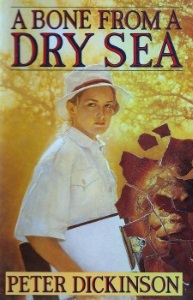
by Peter Dickinson
Delacorte 201 pp.
3/93 0-385-30821-3 $16.00
As he did in his acclaimed novel Eva, Dickinson uses other primate life forms to shed light on our humanity, in this case going back rather than forward in time. Two parallel stories are told in alternating chapters. In the first story, Vinny is spending the summer with her archaeologist father on a dig in Africa. As she is drawn into his work, analyzing fossils that reveal the mysteries of our prehuman ancestors, she is also making sense of her own life by delving into the nature of the relationship between her divorced parents and herself. Alternate chapters describe the tribe of a tribe of sea apes who, according to a controversial theory of evolution described in an end note, may have been the direct predecessors of our human ancestors. Dickinson does a masterful job of creating a believable culture of hominids who depend on the sea for survival. Their story is told from the perspective of an intelligent young female, whose creative and independent mind enables her to save the remnants of her group after a cataclysmic event destroys their seashore habitat. She alters the course of evolution by leading the group inland to seek fresh water and food. The details of the life of her tribe make fascinating reading. In the book's final chapter, Vinny puzzles over an early artifact and a few fragments of skull that seem to corroborate the sea-ape theory. The pieces of this carefully constructed novel fit together as neatly as these tiny shards of bone. A thoroughly engrossing novel. NANCY VASILAKIS
From the July/August 1993 issue of The Horn Book Magazine.
RELATED
RECOMMENDED
ALREADY A SUBSCRIBER? LOG IN
We are currently offering this content for free. Sign up now to activate your personal profile, where you can save articles for future viewing.







Add Comment :-
Be the first reader to comment.
Comment Policy:
Comment should not be empty !!!